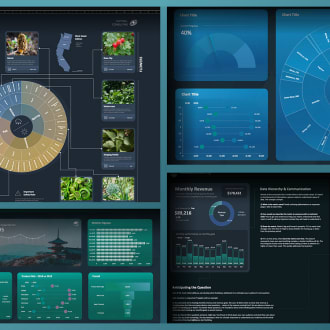
The Best Articles in Data Visualization
The most useful articles in Data Visualization from around the web, curated by thought leaders and our community.
Refind focuses on timeless pieces and updates the list whenever new, must-read articles or videos are discovered.
Top 5 Data Visualization Articles
At a glance: these are the articles that have been most read, shared, and saved in Data Visualization by Refind users in 2024 so far.
How to ...?
How to pick more beautiful colors
Choosing good colors for your charts is hard. This article tries to make it easier.
«There’s no need to rely on hues from all around the color wheel like ⬤⬤⬤⬤⬤⬤ for your visualizations. It will look more professional – and therefore more trustworthy – when it only uses a few hues and their neighbors.»
How to choose a color palette for choropleth maps
Part of creating a choropleth map is to choose colors for our map. It seems simple.
How to visualize decision tree
Decision trees are the fundamental building block of gradient boosting machines and Random Forests(tm), probably the two most popular machine learning models for structured data. Visualizing decision trees is a tremendous aid when learning how these models work and when interpreting models. Unfortunately, current visualization packages are rudimentary and not immediately helpful to the novice. For example, we couldn't find a library that visualizes how decision nodes split up the feature space.
Short Articles
Short on time? Check out these useful short articles in Data Visualization—all under 10 minutes.
The limits of our personal experience and the value of statistics
The world is huge; to get a clear idea of what our world is like, we have to rely on carefully collected, well documented statistics.
The Myth of Objective Data
When we view objectivity and subjectivity as opposites rather than complements, we distort the empirical realities of data collection.
«This despair helps my students recognize an apparently banal assignment as a real design situation. It teaches them that data is created, not found; and that creating it well demands humanity, rather than objectivity.»
When is Dinner, By State
These are the states that eat dinner the earliest and latest, along with everyone else in between.
How to make charts and graphs more accessible
Learn how to make charts and graphs more accessible.
Long Articles
These are some of the most-read long-form articles in Data Visualization.
How not to be fooled by viral charts
Part 1: How to spot misinformation, mistakes, and meaningless data
Dashboards Are Dead: 3 Years Later
What’s the purpose of dashboards in 2023?
Our Top 22 Visualizations of 2022
The world was a complex and volatile place in 2022. In our signature style—combining art, data, and storytelling—we helped millions of people make sens
How to get started with data visualization
A subjective and practical guide on what to do if you want to create data visualizations yourself (including lots of exercises and examples!)
Excel is your most overlooked design tool
A designer’s perspective on the world’s #1 spreadsheet tool — how to build infographics, dashboards, presentations & more
Thought Leaders
We monitor hundreds of thought leaders, influencers, and newsletters in Data Visualization, including:
What is Refind?
Every day Refind picks the most relevant links from around the web for you. Picking only a handful of links means focusing on what’s relevant and useful.
How does Refind curate?
It’s a mix of human and algorithmic curation, following a number of steps:
- We monitor 10k+ sources and 1k+ thought leaders on hundreds of topics—publications, blogs, news sites, newsletters, Substack, Medium, Twitter, etc.
- In addition, our users save links from around the web using our Save buttons and our extensions.
- Our algorithm processes 100k+ new links every day and uses external signals to find the most relevant ones, focusing on timeless pieces.
- Our community of active users gets the most relevant links every day, tailored to their interests. They provide feedback via implicit and explicit signals: open, read, listen, share, mark as read, read later, «More/less like this», etc.
- Our algorithm uses these internal signals to refine the selection.
- In addition, we have expert curators who manually curate niche topics.
The result: lists of the best and most useful articles on hundreds of topics.
How does Refind detect «timeless» pieces?
We focus on pieces with long shelf-lives—not news. We determine «timelessness» via a number of metrics, for example, the consumption pattern of links over time.
How many sources does Refind monitor?
We monitor 10k+ content sources on hundreds of topics—publications, blogs, news sites, newsletters, Substack, Medium, Twitter, etc.
Who are the thought leaders in Data Visualization?
We follow dozens of thought leaders in Data Visualization, including Mona Chalabi, Mike Bostock, Data Pointed, Nathan Yau, David Bauer.
Missing a thought leader? Submit them here
Can I submit a link?
Indirectly, by using Refind and saving links from outside (e.g., via our extensions).
How can I report a problem?
When you’re logged-in, you can flag any link via the «More» (...) menu. You can also report problems via email to hello@refind.com
Who uses Refind?
450k+ smart people start their day with Refind. To learn something new. To get inspired. To move forward. Our apps have a 4.9/5 rating.
Is Refind free?
Yes, it’s free!
How can I sign up?
Head over to our homepage and sign up by email or with your Twitter or Google account.
Keep Learning
Learn something new, guided by experts. Deep Dives are carefully hand-curated series of time-tested articles and videos from around the web.
Get the big picture on your favorite topics.











